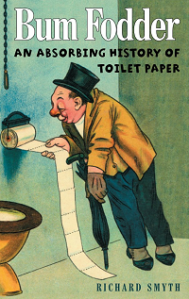Bum Fodder by Richard Smyth is an absorbing look at how we moved from the early days of leaf-wiping, to the modern age of toilet paper, and beyond, into the age of the Washlet. With World Toilet Day highlighting the importance of access to sanitation worldwide, we thought we’d share four facts about the past, present(ish) and future of toilet paper.
- Toilet paper originated in China. Like the invention of paper in around 100 CE, though it is unclear when the transition was made from writing to wiping material.
- The neck of a live goose is the finest means of wiping one’s behind. At least according to the works of Rabelais, a French priest and scholar in the 1500s. He created the character of Gargantua, who amused the masses in tales of exploration in bum-wiping. Which concluded – naturally – that the neck of a live goose was the best thing you could use.
- In 2010 a French photography prize was awarded to a photo of a man using the tricolor to wipe with. It caused a national outrage but, as far as we know, no-one was prosecuted.
- The future is the Washlet. Because who doesn’t want to be rinsed clean with some warm water and then dried with a blast of air. Now all the rage in Japan, but coming soon to a bathroom near you.
(Facts taken from Bum Fodder by Richard Smyth)
But this World Toilet Day, a UN-recognised event observed annually on 19th November, stop and think. We don’t need Washlets. We don’t need the necks of live geese. Just a clean, safe toilet.
Can you imagine not having a toilet? 2.5 billion people worldwide do not have access to a clean and safe toilet. Having access to safe, clean and private toilet facilities is proven to be a contributing factor in keeping girls in school, and increasing the chances of girls completing their education. Access to proper sanitation has been declared a human right for all, and yet 2.5 billion people still don’t have that. Visit the World Toilet Day website for more information.


